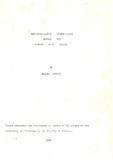| dc.description.abstract | Prior to a discussion of the experimental results, a review of
regional induction studies is presented, which emphasises the strengtbs
and limitations of the magnetotelluric technique.
The fundamental theory and equation of the magnetotelluric data are
discussed.
Instrumentation used for recording magnetotelluric variations in
Kenya is described.
Magnetotelluric measure~ents were made at fourteen stations in
Kenya, between July 1973 and May 1974. The ma.in group formed a 300 km
long east-west line crossing the Rift Valley at the geographic equator.
Telluric field and magnetic field variations were recorded in the period
range 10 to 1000 seconds.
Data from all sites have been analysed to obtain principal impedances
and single station induction vectors. Possible sources· of systematic
error involved in the data reduction process have been investigated.
In particular, the biasing effect of strong source field polarisation
has been taken into account.
Transfer func t.Lons expressed in maximum- and minimum- response
form indicate a current concentration at shallow depths flowing along the
axis of the Rift ValJey and are in accord with the results of Banks and
Ottey ~1-974).
Maximum apparent resistivities measured at stations inside the
Rift Valley and on its escarpments ('Rift stations') are more than one
order of magnitude smaller than th~aximum apparent resistivities
measured at stations outside the Rift Valley.
In addition, the
azimuths of maximum resistivity axes are oriented approximately parallel
to the main rift faults at 'Rift stations' and approximately perpendicular
to the main rift faults at stations away from the Rift Valley. The
apparent resistivity data suggest that some tens of kilometers of
conductive material lie under the rift valley and that the western and
eastern edges of this conductor lie outside the region defined by the
major rift faults.
Only data which is believed to be relatively unaffected by sources
of systematic error have been selected for interpretation in terms of
conductivity models. This eliminates the highly anisotropic apparent
resistivity data obtained at all stations away from the Rift Valley,
and also induction arrows calculated at stations to the east of the
rift valley, where the inductive response is complex.
Greatest weight
has been placed on the high quality isotropic data collected at 01 Joro
Orok, a station on the eastern escarpment of the Rift Valley.
Simultaneous magnetic variation measurements made at stations
200 km apart suggest that the horizontal di~ensions of the inducing
field do not significantly affect the main conclusions of the
interpretation.
The magnetotelluric data provide the first independent evidence,
for the existence 01 high conductivities at depths corresponding to
the upper mantle below the Kenyan Rift ·Valley.
The conclusions of previous Geomagnetic Depth Sounding in the region were heavily dependent
upon other geophysical and geological data.
An explanation of the upper mantle conductor in terms of partial melting is in accord with
geological evidence of recent volcanic activity in the area.
The depth to the top of and the thickness of the upper mantle
conductor can not be resolved by the MT data since the mantle conductor
is obscured by the presence of a good conductor at depths « 10 km )
corresponding to the upper crust. The high conductivity of upper
crustal material can only reasonably be explained in terms of high
temperatures and water saturation of the crust under the rift valley.
The conductivity model and its geophysical implications are similar
to those suggested by Hermance (1973b) and Berktold (1974) in their
interpretations of magnetotelluric data collected in Iceland and
Ethiopia, respectively.
The possible existence of large quantities of water in the crust
below the Kenyan Rift Valley and in the Sub-Icelandic and Sub-Ethiopian
crusts suggests a relationship- between high water concentration', high
temperatures and tectonic activity. The presence of water in rocks at
high temperatures is of considerable interest in the understanding of
the petrology of rocks in the region of the Rift Valley. | |

